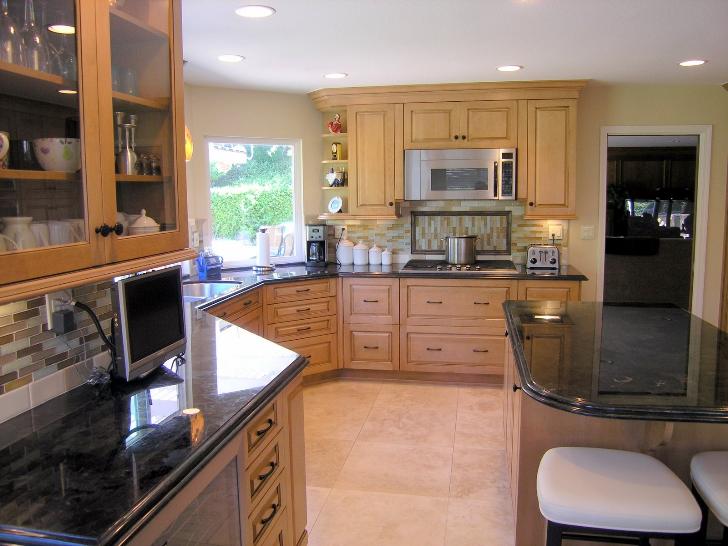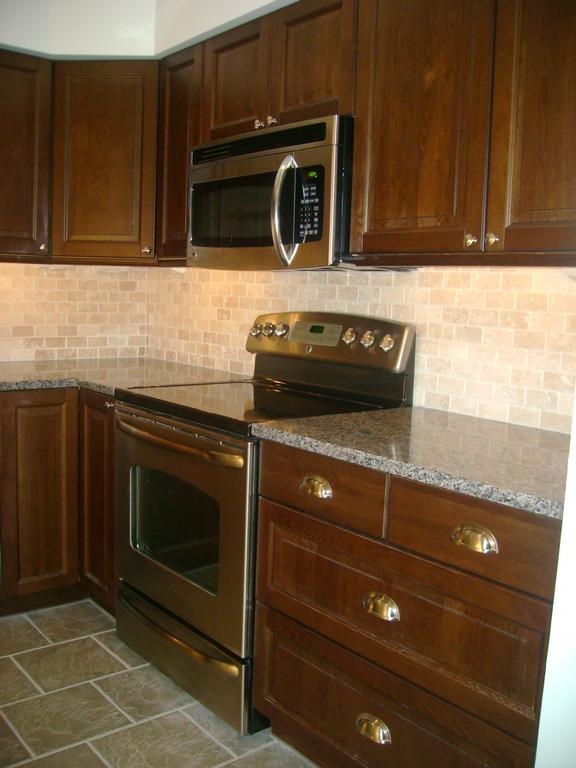Small kitchen backsplashes are an essential element of modern kitchen design, serving both functional and aesthetic purposes. These carefully selected materials cover the wall space between the countertop and the upper cabinets or range hood, protecting from splashes, spills, and grease while adding style and personality to the kitchen. A well-chosen backsplash can elevate the appearance of a small kitchen, making it appear larger and more cohesive. When designing a small kitchen backsplash, it’s crucial to consider the space constraints, the overall kitchen theme, and the balance between durability and aesthetic appeal.
Material selection plays a vital role in creating an effective and visually appealing backsplash. Options range from classic ceramic tiles to luxurious marble or granite, as well as more budget-friendly choices like peel-and-stick tiles or stainless steel. Each material has its advantages and drawbacks, and selecting the right one depends on factors such as maintenance, longevity, and compatibility with the kitchen’s design. For instance, ceramic and porcelain tiles are popular due to their affordability, versatility, and ease of cleaning. On the other hand, natural stones like marble or travertine provide a timeless elegance but require regular sealing and maintenance.

The choice of color and pattern for a small kitchen backsplash is another critical consideration. Light and neutral tones are generally recommended for small kitchens as they reflect light and create an illusion of more space. Patterns can also play a significant role, with subtle designs such as subway tiles offering a clean and classic look. For those who want to add a bold touch, geometric or mosaic patterns can create a focal point, but it’s important to balance them with simpler elements to avoid overwhelming the space. A well-planned color palette ensures that the backsplash complements the cabinets, countertops, and overall kitchen décor.
Lighting enhances the appearance of a small kitchen backsplash and brings out its full potential. Under-cabinet lighting, in particular, can highlight the textures and colors of the backsplash, creating a warm and inviting ambiance. LED strip lights are an excellent choice, as they are energy-efficient and available in various color temperatures. A well-lit backsplash not only improves the functionality of the workspace but also adds depth and dimension to the kitchen design.

The installation process is another important aspect of designing a small kitchen backsplash. While professional installation ensures a flawless finish, many homeowners opt for DIY methods to save costs. Pre-measured and pre-cut peel-and-stick tiles are particularly popular among DIY enthusiasts due to their simplicity and convenience. However, traditional materials like ceramic tiles or natural stone require more expertise and tools, including tile cutters, grout, and adhesive. Ensuring precise measurements and alignment is crucial for achieving a seamless and professional-looking result.
Maintenance is a key factor to consider when selecting and installing a backsplash in a small kitchen. Since the backsplash is constantly exposed to spills, heat, and moisture, choosing a material that is easy to clean and resistant to stains is essential. Ceramic and glass tiles are highly recommended for their low-maintenance properties, as they can be wiped clean with a damp cloth and mild detergent. In contrast, materials like natural stone and stainless steel require more effort to keep in pristine condition, with regular sealing or polishing often necessary.

Budget constraints often influence the choice of materials and designs for small kitchen backsplashes. Homeowners looking for cost-effective options can explore peel-and-stick tiles, laminate sheets, or even painted backsplashes with waterproof coatings. For those with a larger budget, custom designs using high-quality materials like glass or quartz can create a unique and luxurious look. By comparing prices and exploring different suppliers, homeowners can find solutions that fit their budget without compromising on quality or style.
Design trends also play a role in influencing backsplash choices. Contemporary trends emphasize minimalism, with clean lines and monochromatic schemes dominating small kitchen designs. Bold and artistic backsplashes are also gaining popularity, featuring hand-painted tiles, metallic finishes, or eco-friendly materials like recycled glass. Staying updated with trends allows homeowners to incorporate modern touches into their kitchens, ensuring a timeless yet current appeal.
For small kitchens, maximizing space is always a priority, and a well-designed backsplash can contribute to this goal. Mirrored backsplashes, for instance, can create an illusion of depth and make the kitchen appear larger. Similarly, extending the backsplash to cover an entire wall or up to the ceiling can add verticality to the design. By utilizing creative approaches, a backsplash can go beyond its functional purpose and transform into a space-enhancing feature.

Customization is another way to add personality to a small kitchen backsplash. Homeowners can personalize their backsplash with unique designs, such as incorporating family initials, hand-painted tiles, or even a custom mural. This not only makes the kitchen stand out but also adds sentimental value to the space. Customization options allow homeowners to express their style and make their kitchen a true reflection of their personality.
Eco-friendly options are becoming increasingly popular for backsplashes, with many homeowners seeking sustainable and environmentally conscious materials. Recycled glass tiles, bamboo panels, and cork are excellent choices for creating a green kitchen. These materials not only reduce environmental impact but also offer a unique and modern aesthetic. Choosing eco-friendly options can also qualify for green building certifications, adding value to the property.
Combining functionality and aesthetics is the ultimate goal when designing a small kitchen backsplash. For instance, incorporating magnetic strips or pegboards into the backsplash can provide additional storage for knives, utensils, or spices. This not only optimizes space but also keeps frequently used items within easy reach. By integrating practical features, a backsplash can contribute to a more organized and efficient kitchen.

DIY enthusiasts often explore creative and unconventional materials for backsplashes, such as chalkboard paint, wallpaper with a waterproof coating, or even repurposed wood. These alternatives can add a rustic or whimsical charm to the kitchen while keeping costs low. However, it’s essential to ensure that these materials can withstand the heat and moisture typically present in kitchens.
The durability of the backsplash material is particularly important for small kitchens where the cooking area is in close proximity to the walls. High-quality materials that resist cracking, chipping, and discoloration are ideal for long-term use. Investing in durable materials not only reduces maintenance efforts but also ensures the backsplash retains its appearance and functionality over time.
Regular updates to the backsplash can refresh the look of a small kitchen without requiring a complete remodel. Changing the backsplash color, pattern, or material allows homeowners to keep up with evolving trends and personal preferences. Temporary solutions like removable wallpaper or peel-and-stick tiles are excellent for those who enjoy experimenting with different styles.
A harmonious backsplash design is essential for creating a cohesive kitchen aesthetic. Coordinating the backsplash with the countertop, flooring, and cabinetry ensures that all elements work together seamlessly. By considering the overall kitchen design as a whole, homeowners can achieve a balanced and visually pleasing result.

Common Mistakes to Avoid
Overcomplicating the Design: Incorporating too many colors, patterns, or textures can make a small kitchen feel cluttered. Opt for a simple, cohesive design that complements the existing décor.
Neglecting Maintenance Requirements: Choosing a high-maintenance material without understanding its upkeep can lead to frustration. Ensure the material suits your cleaning habits and lifestyle.
Improper Installation: Misaligned tiles or uneven grout can ruin the appearance of the backsplash. Professional installation or careful DIY preparation is crucial.
Ignoring Lighting Needs: Without proper lighting, even the most beautiful backsplash can go unnoticed. Invest in under-cabinet lighting to enhance visibility and aesthetics.
Overlooking Functionality: While aesthetics are important, the primary purpose of a backsplash is to protect the walls. Ensure the material is durable and easy to clean.
Choosing Incompatible Materials: Some materials, like natural stone, may not suit high-moisture or high-heat areas. Consider the kitchen environment when selecting materials.

What are the best materials for a small kitchen backsplash?
The best materials for a small kitchen backsplash depend on your budget, style, and maintenance preferences. Ceramic and porcelain tiles are cost-effective, durable, and easy to clean. Glass tiles add a modern touch and reflect light to make the kitchen appear larger. For a luxurious look, natural stones like marble are excellent but require regular maintenance. Peel-and-stick tiles are a great option for renters or those on a budget, as they are easy to install and remove.
How can I make my small kitchen look bigger with a backsplash?
To make a small kitchen appear larger, choose light-colored backsplashes that reflect light and create an open feel. Consider using glass or mirrored tiles for their reflective properties. Extending the backsplash to the ceiling or using large-format tiles can also create an illusion of space by reducing visual clutter. Combining these elements with good lighting further enhances the effect.
Can I install a backsplash myself?
Yes, installing a backsplash can be a DIY project, especially with user-friendly materials like peel-and-stick tiles or pre-cut panels. However, traditional tiles, natural stones, or complex patterns may require advanced tools and skills. Ensure you measure accurately, use appropriate adhesives, and follow installation guidelines for a professional-looking result.

How often should I clean my backsplash?
The frequency of cleaning depends on the material and how often you cook. For most kitchens, wiping down the backsplash after each cooking session with a damp cloth and mild detergent is sufficient. Materials like stainless steel or glass may show smudges and require more frequent attention, while sealed stone backsplashes need periodic resealing for stain resistance.
What are the current trends for small kitchen backsplashes?
Current trends include minimalist designs with clean lines and neutral tones, as well as bold, artistic patterns like geometric or hand-painted tiles. Eco-friendly materials like recycled glass and bamboo are gaining popularity, along with metallic finishes for a modern-industrial look. Custom designs and textured tiles also allow homeowners to personalize their space.
Are peel-and-stick tiles a durable option for backsplashes?
Peel-and-stick tiles are a convenient and budget-friendly option for backsplashes, but their durability depends on the quality of the product and the installation process. They work well in low-heat and low-moisture areas but may not hold up as effectively near stoves or sinks. Proper surface preparation and careful application are crucial to maximizing their lifespan.

Retro Kitchen Ideas to Upgrade Your Current Kitchen

Don’t love the Border. oven backsplash tile behind stove only stainless steel

Related Posts:
- Kitchen Backsplash For Dark Wood Cabinets
- Affordable Kitchen Makeover Wallpaper Backsplash
- Luxury Kitchen Backsplash
- Kitchen Counter Backsplash Pictures
- Kitchen Remodel Backsplash
- Wainscoting For Kitchen Backsplash
- Brick Veneer Kitchen Backsplash
- Kitchen Backsplash White Cabinets Brown Countertop
- Kitchen Cabinet Tile Backsplash
- Cheap DIY Kitchen Backsplash Ideas